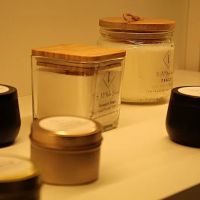What Are the Ingredients of Scented Candles?
1. Types of Wax Used in Scented Candles
The foundation of any scented candle is its wax. Different types of wax provide unique burning qualities and influence the way the fragrance is released. Some of the most common wax types include:
1.1 Paraffin Wax
Paraffin wax is one of the most widely used waxes in candle-making due to its affordability and excellent fragrance throw. It is derived from petroleum and offers a clean, consistent burn when used correctly.
1.2 Soy Wax
Soy wax, made from soybean oil, is a popular eco-friendly choice. It burns slower than paraffin and creates a softer, more natural scent throw. Soy wax candles are also biodegradable.
1.3 Beeswax
Beeswax candles are known for their natural honey aroma and clean-burning qualities. They are often used in premium candles and provide a luxurious experience.
1.4 Coconut Wax
Coconut wax, derived from coconut oil, is a premium wax that offers an exceptional scent throw and smooth finish. It is often blended with other waxes to enhance its properties.
2. Fragrance Oils: Bringing Scent to Life
Fragrance oils are the heart of any scented candle. These oils are either synthetic or natural and provide the distinct aroma that defines the candle. High-quality fragrance oils ensure a consistent and pleasant scent throughout the candle’s life.
2.1 Essential Oils
Some scented candles use essential oils, extracted from natural sources like plants and flowers, for a more authentic and therapeutic experience. However, these oils are often pricier.
2.2 Synthetic Fragrance Oils
Synthetic oils are crafted in labs to replicate natural scents or create entirely new fragrances. They are more cost-effective and offer a broader range of aromas.
id="wicks">3. Wicks: The Unsung Hero of Candles
The wick plays a critical role in how a candle burns and releases fragrance. Common materials for wicks include cotton, wood, or hemp. A well-chosen wick ensures an even burn and maximizes the scent throw.
3.1 Cotton Wicks
Cotton wicks are the most popular choice for their consistency and clean-burning properties. They are often braided or twisted for strength and durability.
3.2 Wooden Wicks
Wooden wicks offer a crackling sound reminiscent of a fireplace, creating a cozy ambiance. They burn slower and are often used in high-end candles.
4. Additives and Dyes: Enhancing the Candle Experience
To create visually appealing and functional candles, manufacturers use additives and dyes. These components enhance the candle’s color, texture, and burn quality.
4.1 UV Inhibitors
UV inhibitors are used to prevent discoloration caused by sunlight exposure, ensuring the candle retains its vibrant appearance.
4.2 Candle Dyes
Dyes are added to give candles their signature hues. From soft pastels to bold colors, these dyes add aesthetic appeal.
5. How to Choose High-Quality Scented Candles
When selecting a scented candle, consider its ingredients, burn time, and fragrance intensity. High-quality candles often list their materials, ensuring transparency. For a luxurious experience, explore premium options like coconut wax candles with wooden wicks.
Ready to explore high-quality scented candles? Visit Scent Snob for a curated selection of premium options designed to elevate your space with captivating aromas.



0 comments